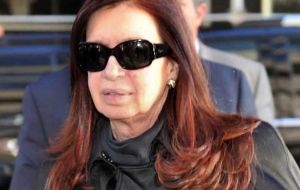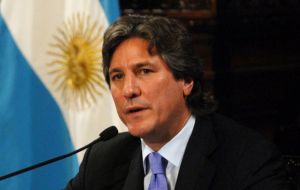MercoPress. South Atlantic News Agency
Cristina Fernandez prescribed 30 days medical rest, until after mid-term election
 The Argentine president was diagnosed ‘chronic subdural collection’ following a mild head injury in August
The Argentine president was diagnosed ‘chronic subdural collection’ following a mild head injury in August Argentine President Cristina Fernández was diagnosed “chronic subdural collection” and prescribed one month of rest after suffering cardiac arrhythmia, according to the official release from Government House on Saturday. Vice President Amado Boudou will manage the Cabinet for the upcoming 30 days.
The late evening announcement said President Cristina Fernandez left the medical centre belonging to the Fundación Favaloro after undergoing a medical check up and neurological tests following complaints of migraine. All in all she spent over 10 hours in the hospital.
The Argentine president underwent complementary Echo Doppler studies initiated on Wednesday. She didn't run her agenda that day. Latest routine exams date back to August.
The president’s most recent routine medical exams took place in August at the Otamendi clinic. According to the Presidential Medical Unity, Cristina Fernández underwent a Mammography and Pap test as well as other studies. Her grandson Néstor Ivan was born at the Otamendi earlier this year.
In January 2012, the head of state had surgery to remove her thyroid gland; first government versions said Cristina Fernandez was suffering from thyroid cancer, diagnose that was later officially denied. The Argentine president has had several admissions mostly related to blood pressure conditions.
In April 2011, she presented a low blood pressure episode that forced her to take a 24-hour medical leave and called off her agenda. Later in October that same year, the Argentine president was diagnosed with a similar condition.
In October 2009, the president of Argentina had to suspend an official visit to Cuba also for a pressure-related problem taking a week off from office.
The official release was read out by Public Communications Secretary Alfredo Scoccimarro and is signed by the two doctors from the Presidential Unit, Luis Buonomo and Marcelo Ballesteros. The text follows:
“The president of the Nation Dra Cristina Fernandez suffered last 12 August a cranium traumatism for which she underwent a cranium computerized tomography at the Otamendi clinic which resulted normal.
Later the President did not present further symptoms.
On 5 October Dra Cristina Fernandez attended the Fundacion Favaloro medical centre for a cardio-vascular test because of an arrhythmia under study, and since the patient presented migraine, a neurological assessment was requested from the Neurosciences Institute, belonging to that foundation and under management of Dr Facundo Manes.
Once the corresponding control tests were done in the institute, the diagnosis was of chronic subdural collection. Because of the mentioned diagnose, a month’s rest was prescribed together with a strict clinic and medical-imagining evolution follow-up”.
A chronic subdural is defined as an “old” collection of blood and blood breakdown products between the surface of the brain and its outermost covering (the dura). The chronic phase of a subdural collection begins several weeks after the first bleeding.
A subdural collection develops when the tiny veins that run between the dura and surface of the brain (bridging veins) tear and leak blood. This is usually the result of a mild head injury.
A collection of blood then forms over the surface of the brain. In a chronic subdural collection, blood leaks from the veins slowly over time, or a fast hemorrhage is left to clear up on its own.
A subdural collection is more common in the elderly because of normal brain shrinkage that occurs with aging. This shrinkage stretches and weakens the bridging veins. These veins are more likely to break in the elderly, even after a minor head injury.
Based on the medical report the cranium traumatism of the president occurred a day after Argentina’s primary elections previous to mid term elections, August 12. The prescribed rest means the head of state will be out of combat until 5 November, thus theoretically missing the 27 October mid term election. In the August primary three out of four ballots supported the opposition to President Cristina Fernandez.





Top Comments
Disclaimer & comment rules-

-

-

Read all commentsIn other words, 16 paragraphs later, a subdural hematoma, resulting or associated from an incident of head trauma..
Oct 06th, 2013 - 06:56 am 0That is a serious, life-threatening diagnosis. Not a good sign.
head trauma ? that would explain a lot
Oct 06th, 2013 - 08:08 am 0Well in order to emulate Peron you are supposed to die young. I don't think song went - “when they bring your curtain down, demand to look like Jackie Stallone”.
Oct 06th, 2013 - 08:20 am 0Commenting for this story is now closed.
If you have a Facebook account, become a fan and comment on our Facebook Page!